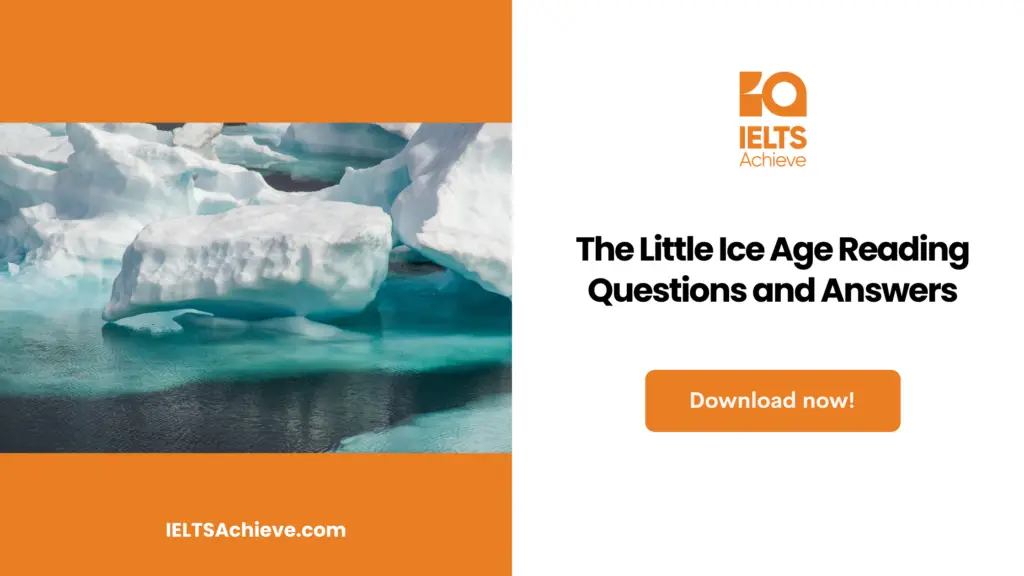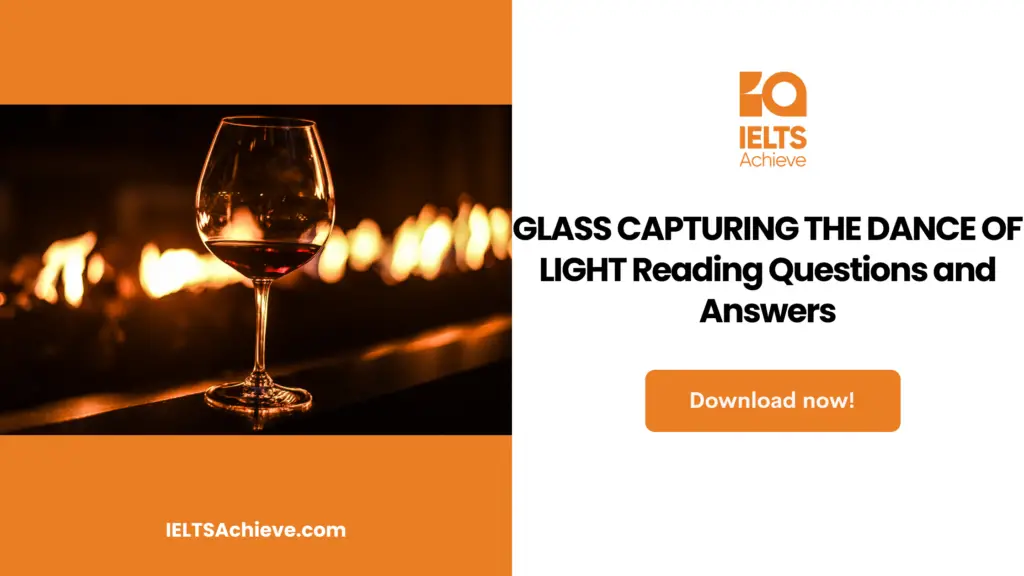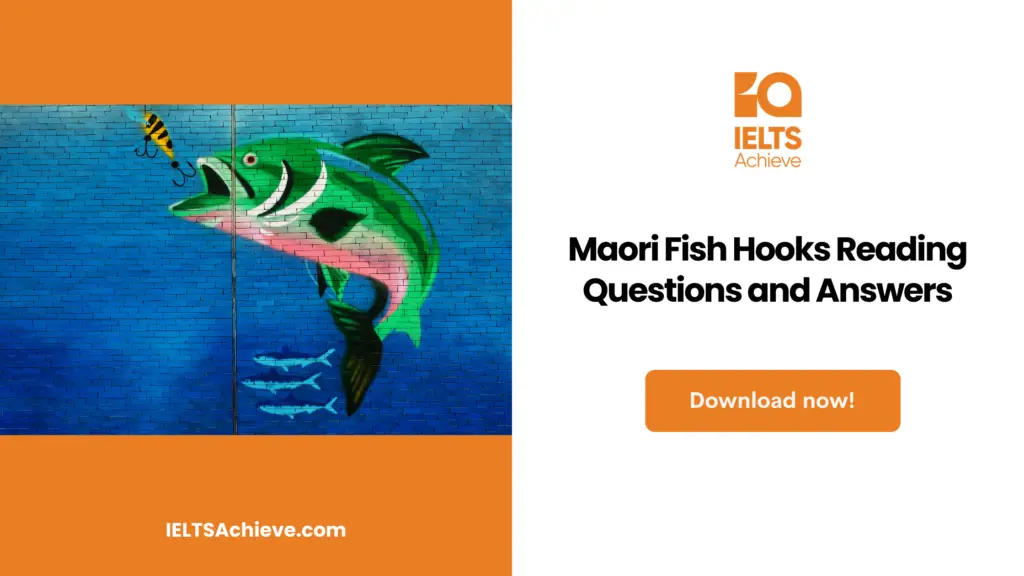The Blog post contains the following IELTS Reading Questions:
- IELTS Reading Matching Sentence Endings
- IELTS Reading Sentence completion
- IELTS Reading Matching Heading
Stay informed and prepared for success – Explore our comprehensive Reading Test Info page to get valuable insights, exam format details, and expert tips for mastering the IELTS Reading section.
IELTS Reading Passage – The Little Ice Age

The Little Ice Age
In this book, a detailed examination of the Little Ice Age and other climatic shifts is given, however, I will show the historical context before I get into it. We always think of climate – contradicting weather – as something uncertain, yet the human population is under the mercy of climatic change for its whole survival, with a minimum of eight glacial parts in the past 730,000 years and even beyond that. Our ancestors accustomed themselves to the universe but the unpredictable global warming since the end of the last Ice Age, which is nearly 10,000 years ago, with shining opportunism. They came up with new techniques to combat severe drought cycles, heavy rainfall or unimaginable cold. They practised agricultural production and stock-raising that became a part of human life; and founded the world’s first pre-industrial eras like Egypt civilization, Mesopotamia and the Americas. Nevertheless, the cost of sudden climate change, in famine, disease and suffering, was highly intense.
The Little Ice Age period is roughly between 1300 and the middle of the nineteenth century. Europe encountered a series of impacts due to bitterly cold winters a couple of centuries ago; mountain glaciers in the (Swiss) Alps were the lowest, and ice bars surrounded Iceland throughout the year. Events that occurred during the Little Ice Age eventually shaped the world with various geographical changes. The Little Ice Age was never a deep freeze, rather than a seesaw of aggressive climatic shifts, some of which lasted for more than a quarter-century, mainly due to complex connections between the ocean and the atmosphere. The seesaw led to a series of intensely cold winters and easterly winds that evolved into heavy spring and early summer rains, mild winters, and Atlantic storms (came often), or sometimes droughts, light northeasterly winds, and summer heatwaves.
Rebuilding climate changes of the past is nearly impossible, because we started systematic weather observations only a few centuries ago. It’s available in both Europe and North America. On the other hand, data from India and Africa situated in the tropical region are very new. Before doing systematic weather observations, we have had only proxy records taken largely from ice cores and tree ring structures, in addition to a few incomplete accounts that are hand-written. At present, we have hundreds of three-ring records data from the entire northern hemisphere and some from south of the equator, too. These are analysed with increasing body temperature data from ice cores drilled in Greenland, Antarctica, the Peruvian Andes, and many other locations. We have insights on the variations between annual summer and winter temperature in the northern hemisphere 600 years ago.
This book portrays the history of climatic shifts right from the past ten centuries and the ways in which humans in Europe got used to it. In this book, Part One mentions the Mediaeval Warm Period, i.e., close to 900 to 1200. The Norse voyagers from the northern part of Europe experienced the northern seas, settled in Greenland, and explored North America during these three centuries. That time no uniform warmth, as there were constant shifts in weather, temperature and rainfall. When you calculate the mean European temperatures, it was about the same as today but cooler than before.
It is well-aware that the Little Ice Age cooling started first in Greenland and the Arctic in 1200. Since the Arctic ice pack covered southward, Norse voyages were migrated to the open Atlantic and ended their travel. Storminess raised in the North Sea and in the North Atlantic. Freezing cold, much wetter weather descended on Europe during 1315 and 1320, when hundreds of them perished in a famine across the continent. In 1400, the weather were more unpredictable and stormier, having severe twists and lower temperatures that increased in the freezing years of the late sixteenth century. In those days, fish was very important in expanding towns and cities, where food was a serious issue. Dried cod and herring were already the main staples of the fish trade across Europe, however, shifts in water temperatures made fishing fleets to move offshore. The Basques, Dutch, and English were the pioneers of the offshore fishing boats that could sustain a colder and stormier Atlantic. Without anybody’s notice, a steady agricultural revolution in northern Europe arose from concerns over food supplies where the fishing population was overwhelming. The revolution included aggressive commercial farming and the production of animal fodder on land that are new and not previously taken for crops. This rise in productivity from farmland developed some countries from mere receivers to self-sufficient with livestock, food grains and offered protection against natural disasters like famine.
Global warming began to rise unnoticingly after 1850, during the beginning of the Modern Warm Period. In this period, a mass migration from Europe took place by poor farmers and other communities, due to the famine caused by the Irish potato blight, to North America, Australia, southern Africa and New Zealand. Tens and thousands of hectares of forest area fell ahead of the freshers’ axes between 1850 and 1890, as the European farming process spread around the world. The unprecedented land clearance revealed huge quantities of carbon dioxide into the atmosphere, causing the starting point of human-based global warming. Temperatures raised frequently in the twentieth century as the use of fossil fuels catalysed, and greenhouse gases seemed to soar continuously. The rise has been even sharper right from the early 1980s. Thus, the Little Ice Age has made extreme weather events like Category 5 hurricanes that are more frequent. Similarly, it has offered a path to a new climatic action because of prolonged and gradual warming.
Unlock your full potential in the IELTS Reading section – Visit our IELTS Reading Practice Question Answer page now!
Recommended Questions:
Renewable Energy IELTS Reading Question with Answer
The Little Ice Age Reading Questions
Questions 1 – 5
The reading passage has six paragraphs, A – F.
Choose the correct heading for each paragraph from the list of headings below.
Write the correct roman number, i – vii, as your answer to each question.
List of Headings
i) Little Ice Age and its impact on Europe
ii) Replacement of Fishing
iii) Reconstruction of climate change
iv) The Little Ice Age and its civilizations
v) Human induced global warming
vi) European Temperature
- Paragraph A
- Paragraph B
- Paragraph C
- Paragraph D
- Paragraph E
Ready to conquer Matching Headings questions? Click here to learn essential tips and techniques for matching headings accurately to paragraphs or sections in the IELTS Reading section.
Questions 6 – 10
Complete each sentence with the correct ending
Write the correct letter a-g in boxes 6 – 10 on your answer sheet
6. These are analysed with increasing body temperature data
7. The revolution included aggressive commercial farming
8. Before doing systematic weather observations
9. The rise has been even sharper10. They practised agricultural production
- we have had only proxy records taken largely from ice cores and tree ring structures.
- right from the early 1980s.
- from ice cores drilled in Greenland, Antarctica, the Peruvian Andes.
- productivity from farmland developed some countries from mere receivers to self-sufficient.
- and the production of animal fodder on land.
- and stock-raising that became a part of human life.
- lower temperatures that increased in the freezing years of the late sixteenth century.
Ready to sharpen your skills in Matching Sentence Endings? Click here to discover expert strategies and techniques for accurately matching sentence endings with the corresponding information in the IELTS Reading section.
Questions 11 – 13
Complete the sentences below.
Write NOT MORE THAN TWO WORDS from the passage for each answer.
11. Events that occurred during the Little Ice Age eventually shaped the world with various ______________. 12. Temperatures raised frequently in the twentieth century as the use of ________ catalysed, and greenhouse gases seemed to soar continuously. 13. They came up with new techniques to combat severe ___________, heavy rainfall or unimaginable cold.
Enhance your sentence completion skills in the IELTS Reading section. Click here to access our comprehensive guide and learn effective strategies for filling in missing words or phrases in sentences.
Unlock your full potential in the IELTS Reading section – Visit our IELTS Reading Practice Question Answer page now!
Recommended Questions:
Renewable Energy IELTS Reading Question with Answer
The Little Ice Age Reading Answers
1. iv
2. i)
3. iii) (h6)
4. vi)
5. ii)
6. C
7. E
8. A
9. B
10. F
11. Geographical changes
12. Fossil fuels
13. Drought cycles

We hope you found this post useful in helping you to study for the IELTS Test. If you have any questions please let us know in the comments below or on the Facebook page.
The best way to keep up to date with posts like this is to like us on Facebook, then follow us on Instagram and Pinterest. If you need help preparing for the IELTS Test, join the IELTS Achieve Academy and see how we can assist you to achieve your desired band score. We offer an essay correction service, mock exams and online courses.

